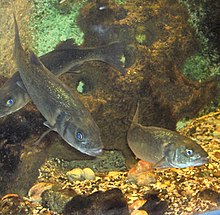| Moronidae | |
|---|---|

| |
| European seabass (Dicentrarchus labrax) | |
| Scientific classification | |
| Domain: | Eukaryota |
| Kingdom: | Animalia |
| Phylum: | Chordata |
| Class: | Actinopterygii |
| Order: | Acanthuriformes |
| Family: | Moronidae D. S. Jordan & Evermann, 1896[1] |
| Genus | |
|
see text | |
The Moronidae is a family of percomorph fishes, commonly called the temperate basses, in the order Moroniformes. These fishes are found in the freshwaters of North America and the coastal waters of the North Atlantic.
Taxonomy
[edit]Moronidae was first proposed as a family in 1896 by the American ichthyologists David Starr Jordan and Barton Warren Evermann.[1] The 5th edition of the Fishes of the World classifies this family in the order Moroniformes with the Ephippidae and Drepaneidae.[2] Other authorities place the Ephippidae and Drepaneidae in the order Ephippiformes with the Moronidae classified as incertae sedis in the series Eupercaria.[3] Other authorities classify all three families in the Moroniformes sensu Fishes of the World in the Acanthuriformes.[4]
Genera
[edit]

Moronidae basses are classified within the two living genera Morone and Dicentrarchus as follows:[2][5]
- Dicentrarchus T. N. Gill, 1860
- D. labrax(Linnaeus, 1758) - (European seabass)
- D. punctatus (Bloch, 1792) - (spotted seabass)
- Morone Mitchill, 1814
- M. americana J. F. Gmelin, 1789) - (white perch)
- M. chrysops Rafinesque, 1820) - (white bass)
- M. mississippiensis D. S. Jordan & C. H. Eigenmann, 1887 - (yellow bass)
- M. saxatilis (Walbaum, 1792) - (striped bass)
- †Beaumontoperca Gaudant, 2000 (Oligocene; Europe)
- †Cockerellites Jordan & Hanibal, 1923 (Eocene; North America)
- †C. liops Cope, 1877 (Ypresian; United States)
- †Paramorone David, 1946 (Eocene; North America)[6]
- †P. eocenica David, 1946 (Priabonian; United States)
- †Priscacara Cope, 1877 (Eocene; North America)
The genus Lateolabrax had formerly been classified in the Moronidae but is now placed in either Polyprionidae[2] or Lateolabracidae.[4]
Description
[edit]Moronidae basses have oblong bodies which are slightly compressed. They have large mouths with the upper jaw being broad to the rear, leading to most of the jaw being exposed when the mouth is closed. The jaws have bands of small, conical teeth with no canine-like teeth. There are also bands of simple teeth on the sides and front of the roof of the mouth. There are also 2 parallel bands of simple teeth on the base of the tongue. The operculum has 3 flat spines while the preoperculum is finely toothed.[7] The first dorsal fin has between 8 and 10 spines and the second has a single spine and between 10 and 13 soft rays. The anal fin has 3 spines and between 9 and 12 soft rays,[2] and has its origin far to the rear of the origin of the second dorsal fin. The caudal fin is forked and the caudal peduncle has a dense covering of scales. The head and body are covered in small, rough scales. There are between 50 and 72 pores in the continuous lateral line,[7] which extends almost as far as the rear margin of the caudal fin, and there are additional rows of lateral-line scales on the caudal fin over and under the main line.[2] The largest species is the striped bass (Morone saxatilis) with a maximum published total length of 200 cm (79 in) while the smallest is the white bass (M. chrysops) with a maximum published total length of 45 cm (18 in).[5]
Distribution and habitat
[edit]Moronidae basses are only found in the north Atlantic Ocean. The seabasses in the genus Dicentrarchus are found in the eastern Atlantic where they inhabit coastal seas and estuaries from Norway south to northern Africa, including the Mediterranean and Black Seas. The genus Morone is found in eastern North America with one mainly marine species and three largely freshwater species. They have been introduced elsewhere.[2]
Biology
[edit]Moronidae basses move into inshore waters, estuaries and rivermouths in the summer, but in winter they move farther offshore and into deeper waters. The young fish gather in schools, but the adults appear to be more solitary. They are predatory, feeding mainly on shrimp and mollusks, as well as smaller fish.[8]
Utilisation
[edit]Moronidae basses are important target fishes for recreational sea angling, and some species support significant commercial fisheries[9] and are used in aquaculture.[10]
References
[edit]- ^ a b Richard van der Laan; William N. Eschmeyer & Ronald Fricke (2014). "Family-group names of Recent fishes". Zootaxa. 3882 (2): 001–230. doi:10.11646/zootaxa.3882.1.1. PMID 25543675.
- ^ a b c d e f J. S. Nelson; T. C. Grande; M. V. H. Wilson (2016). Fishes of the World (5th ed.). Wiley. pp. 495–497. ISBN 978-1-118-34233-6. Archived from the original on 2019-04-08. Retrieved 2023-03-31.
- ^ Ricardo Betancur-R; Edward O. Wiley; Gloria Arratia; et al. (2017). "Phylogenetic classification of bony fishes". BMC Evolutionary Biology. 17 (162): 162. Bibcode:2017BMCEE..17..162B. doi:10.1186/s12862-017-0958-3. PMC 5501477. PMID 28683774.
- ^ a b Ron Fricke; William Eschmeyer; and Jon David Fong (2020). "GENERA/SPECIES BY FAMILY/SUBFAMILY IN Eschmeyer's Catalog of Fishes". Eschmeyer's Catalog of Fishes.
- ^ a b Froese, Rainer; Pauly, Daniel (eds.). "Family Moronidae". FishBase. February 2023 version.
- ^ David, Lorre R. (1946). "Some Typical Upper Eogene Fish Scales from California". Contributions to Paleontology. IV.
- ^ a b "Family: MORONIDAE, Temperate bass, Temperate Basses". Shorefishes of the Greater Caribbean online information system. Smithsonian Tropical Research Institute. Retrieved 31 March 2023.
- ^ "Fishing Techniques. Basses lining. Technology Fact Sheets". FAO Fisheries and Aquaculture Division [online]. Rome. 17 February 2005. Retrieved 31 March 2023.
- ^ "Temperate Basses (Moronidae)". Connecticut Department of Energy & Environmental Protection. Retrieved 31 March 2023.
- ^ "European Sea Bass". seafish. Retrieved 31 March 2023.